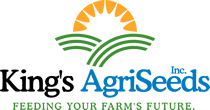By Harold Schrock
Carbon. This is arguably the most important physical factor in all of life, and is the primary nutrient needed for plant growth. There are several aspects of carbon that effect farmers. In plants this material makes the bulk of the dry matter, in soils it is the bulk of the organic matter and it is also a critical component of the atmosphere. A functional carbon cycle has a very practical impact on yields. Other factors being equal a plant grows faster in a higher carbon dioxide atmosphere. Yet too much CO2 in the atmosphere at large may be problematic in the effect it has on our water cycle.
So how do we achieve higher CO2 levels in the crop growing zone? This is a function of carbon dioxide being released from our soils either biologically or chemically. Biologically, just like other animals, soil organisms consume oxygen and release CO2. Chemically, nitrogen fertilizer applications release CO2 as it interacts with stored soil carbon. In both cases stored soil carbon is being released for additional plant growth.
As we need stored carbon released to increase our crops performance we also need to be storing carbon at an equal or greater rate, or our farming operation becomes an enterprise in mining. Fortunately, as plants grow they take in CO2 from the atmosphere at large as well as that released from soil, giving us the opportunity to store more in the soil than is released, leading to higher soil organic matter with all the accompanying benefits. This process of carbon induction and sequestration can lead to better soil biology and subsequently less applied nitrogen needed for good crop performance.
We increase carbon capture by optimizing photosynthesis, the process by which sunshine, water, and CO2 combine to create sugar. This simple soluble carbon combines with minerals to create the rest of plant structure. Directly or indirectly this sugar is also the food source for soil biology.
Optimizing photosynthesis means growing as many green leaves as possible as many months of the year as possible. This is done by planning a crop/cover crop program to keep the soil covered and fertilizing for optimal plant health.
Speak to an expert at King’s AgriSeeds now at 1-717-687-6224 or email us at [email protected].


Recent Comments